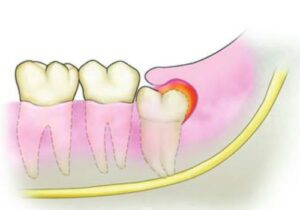If you’re experiencing discomfort and pain in your jaw, especially during the eruption of your wisdom teeth, you may be dealing with pericoronitis – a common oral health issue many people encounter. In this comprehensive guide, Joy International Dental Clinic will provide you with detailed information about wisdom teeth pericoronitis, empowering you to seek timely treatment and prevent potential complications.
Content of table
Toggle1. What is Wisdom Teeth Pericoronitis?

Pericoronitis is a prevalent dental condition that often arises during the wisdom teeth eruption phase. Essentially, it occurs when the wisdom tooth is unable to fully break through the gum tissue, leaving a portion of the tooth covered. This creates a small pocket between the tooth and the gum, which becomes an ideal breeding ground for bacteria and plaque accumulation. Over time, this can lead to inflammation, swelling, pain, and discomfort, significantly impacting the patient’s quality of life. If you’re experiencing these symptoms, let’s delve deeper into this condition with Joy’s detailed explanation.
2. Causes of Wisdom Teeth Pericoronitis
2.1 Pericoronitis Due to Wisdom Tooth Position

Wisdom teeth are the last to emerge in the dental arch, often in a space-constrained environment. Due to their late eruption and the established position of other teeth, several issues can arise:
- Insufficient Jaw Space: The jaw may not have enough room for the wisdom tooth to erupt normally, resulting in partial impaction beneath the gums.
- Crowding and Misalignment: During eruption, wisdom teeth can exert pressure on and displace adjacent teeth, leading to severe crowding and misalignment. Prolonged impaction can also damage the second molar (tooth number 7).
- Difficulty in Cleaning: The unique position of wisdom teeth makes them challenging to clean effectively. Coupled with gum tissue trauma, these teeth can contribute to gingivitis and other gum diseases.
2.2 Pericoronitis Due to Wisdom Tooth Eruption Angle

The eruption angle of wisdom teeth also plays a crucial role in pericoronitis:
- Angled or Horizontal Eruption: Instead of erupting vertically like other teeth, wisdom teeth often emerge at an angle or horizontally, preventing normal gum penetration.
- Complete Bone Impaction: In some cases, wisdom teeth may be completely embedded within the jawbone, invisible from the outside but still exerting pressure on adjacent teeth, causing pain.
- Partial Eruption and Stalling: A wisdom tooth may partially erupt and then cease further movement, creating an ideal environment for bacterial proliferation and oral cavity infections.
3. Recognizing the Signs of Wisdom Teeth Pericoronitis
Early recognition of pericoronitis symptoms enables timely intervention, simplifying treatment. Here are some common signs to look out for:
3.1 Tooth Pain
Tooth pain is a hallmark symptom of pericoronitis. The pain typically starts mildly and intensifies over time, radiating to the jaw, cheeks, and even the ears, significantly impacting your quality of life. Pain often worsens during chewing or exposure to hot or cold foods. It can also occur suddenly and persist for several days.
3.2 Bleeding, Pain, and Soreness in the Gums

In addition to pain, you may notice other symptoms around the wisdom tooth area. The gums surrounding the tooth may swell, redden, and bleed easily during brushing or chewing. The soreness can be persistent and interfere with daily activities. Furthermore, you may experience bad breath due to bacterial accumulation in the pocket between the tooth and gum. In some cases, you may have difficulty opening your mouth or swallowing.
3.3 Fever and Swollen Lymph Nodes
In severe cases, the infection can lead to systemic symptoms such as mild to moderate fever, often accompanied by fatigue. You may also experience swollen lymph nodes in the neck or jaw, which are palpable and tender to the touch. Headaches or earaches may occur due to the spread of infection, leading to decreased appetite and difficulty eating.
4. Treatment Options for Pericoronitis
4.1 Thorough Oral Hygiene

Maintaining meticulous oral hygiene is the first and most crucial step in preventing and managing pericoronitis:
- Proper Brushing Technique: Use a soft-bristled toothbrush and brush gently, paying particular attention to the wisdom tooth area.
- Flossing: Clean thoroughly around the wisdom tooth to remove plaque and food debris.
- Regular Rinsing: Use warm salt water or alcohol-free mouthwash to cleanse and reduce inflammation.
4.2 Antibiotic Use
In cases of infection, your dentist may prescribe antibiotics. It’s essential to use antibiotics only as directed by your dentist to prevent antibiotic resistance and side effects:
- Antibiotics: Help control and inhibit the growth of infection-causing bacteria.
- Short-Term Prescription: Typically prescribed for a short duration with specific usage instructions.
- Pain Relief Combination: May be combined with pain relievers to alleviate discomfort.
4.3 Specialized Mouthwash

Mouthwash plays a vital role in controlling bacteria and reducing inflammation:
- Chlorhexidine Mouthwash: A specialized mouthwash with potent antibacterial and anti-inflammatory properties.
- Proper Usage: Rinse twice daily for approximately 30 seconds each time.
- Avoid Swallowing: Ensure to spit out the mouthwash after use.
4.4 Wisdom Tooth Extraction

Extraction is often the final and most effective solution for resolving pericoronitis permanently. The extraction process can be summarized as follows:
- Thorough Examination: Before extraction, your dentist will conduct a comprehensive examination, including X-rays to determine the precise position of the wisdom tooth.
- Advanced Surgical Techniques: At Joy International Dental Clinic, we utilize advanced and minimally invasive surgical techniques.
- Anesthesia: Depending on the specific case, you may receive local or general anesthesia to ensure a comfortable and painless extraction process.
- Post-Extraction Care: After extraction, you’ll receive detailed instructions on wound care and rapid recovery.
Summary
In conclusion, wisdom teeth pericoronitis is a common condition that can cause significant discomfort and inconvenience. Early recognition and timely intervention are crucial. At Joy International Dental Clinic, we’re committed to providing comprehensive care and support for all your oral health needs. Schedule your free consultation today to ensure your dental health is in optimal condition.






